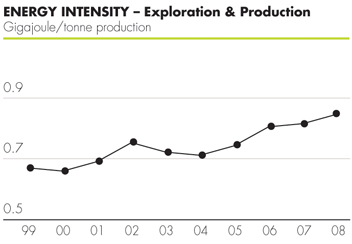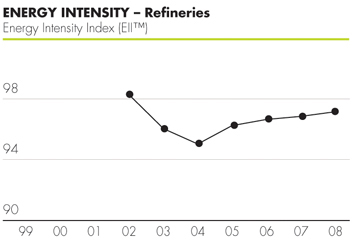Difference between revisions of "Efficiency in energy usuage"
Jump to navigation
Jump to search
| Line 9: | Line 9: | ||
*However oil majors have been developing ways to improve the efficiency driven by the fact that oil is becoming scarce and to drive down their cost base. For example Shell, the refineries in Shell have improved their energy efficiency since 2002. These gains have come from operating refineries closer to full production capacity and running efficiency programs. | *However oil majors have been developing ways to improve the efficiency driven by the fact that oil is becoming scarce and to drive down their cost base. For example Shell, the refineries in Shell have improved their energy efficiency since 2002. These gains have come from operating refineries closer to full production capacity and running efficiency programs. | ||
[[Image:Energy intensity 2009.jpg]] | |||
*The same can be said for BP: For example BP: in 2008 it used 0.97 billion Gigajoules (GJ) to carry out their operations which is 6% lower than in 2007 (1.03 billion GJ) while their production of oil has increased from 3,818 thousand barrels a day in 2007 to 3,838 barrels a day in 2008. | *The same can be said for BP: For example BP: in 2008 it used 0.97 billion Gigajoules (GJ) to carry out their operations which is 6% lower than in 2007 (1.03 billion GJ) while their production of oil has increased from 3,818 thousand barrels a day in 2007 to 3,838 barrels a day in 2008. | ||
Revision as of 09:52, 30 September 2009
- Efficiency in energy use can be divided in two parts: Part 1: Convert primary energy into useful energy and Part 2: the Intensity of which useful energy is used to deliver services
- Part 1: Convert primary energy into useful energy: according to shell it takes 10-15% of every barrel to make one barrel of oil. This is excluding the energy needed to produce and refine the gasoline.
- According to Shell the energy intensity of our oil production. It has risen by around 27% since 2000, there seems to be more energy needed to produce oil from aging fields and more difficult oil.
- However oil majors have been developing ways to improve the efficiency driven by the fact that oil is becoming scarce and to drive down their cost base. For example Shell, the refineries in Shell have improved their energy efficiency since 2002. These gains have come from operating refineries closer to full production capacity and running efficiency programs.
- The same can be said for BP: For example BP: in 2008 it used 0.97 billion Gigajoules (GJ) to carry out their operations which is 6% lower than in 2007 (1.03 billion GJ) while their production of oil has increased from 3,818 thousand barrels a day in 2007 to 3,838 barrels a day in 2008.
Part 2: the Intensity of which useful energy is used to deliver services
- The oil consumption per sector in 2010 is roughly divided as: 50% for transportation, 30% industrial, 10% residential/commercial and 10% electric power
- The oil consumption per sector in 2030 is roughly divided as: 56% for transportation, 33% industrial, 7% residential/commercial and 4% electric power
(link)
Reference

